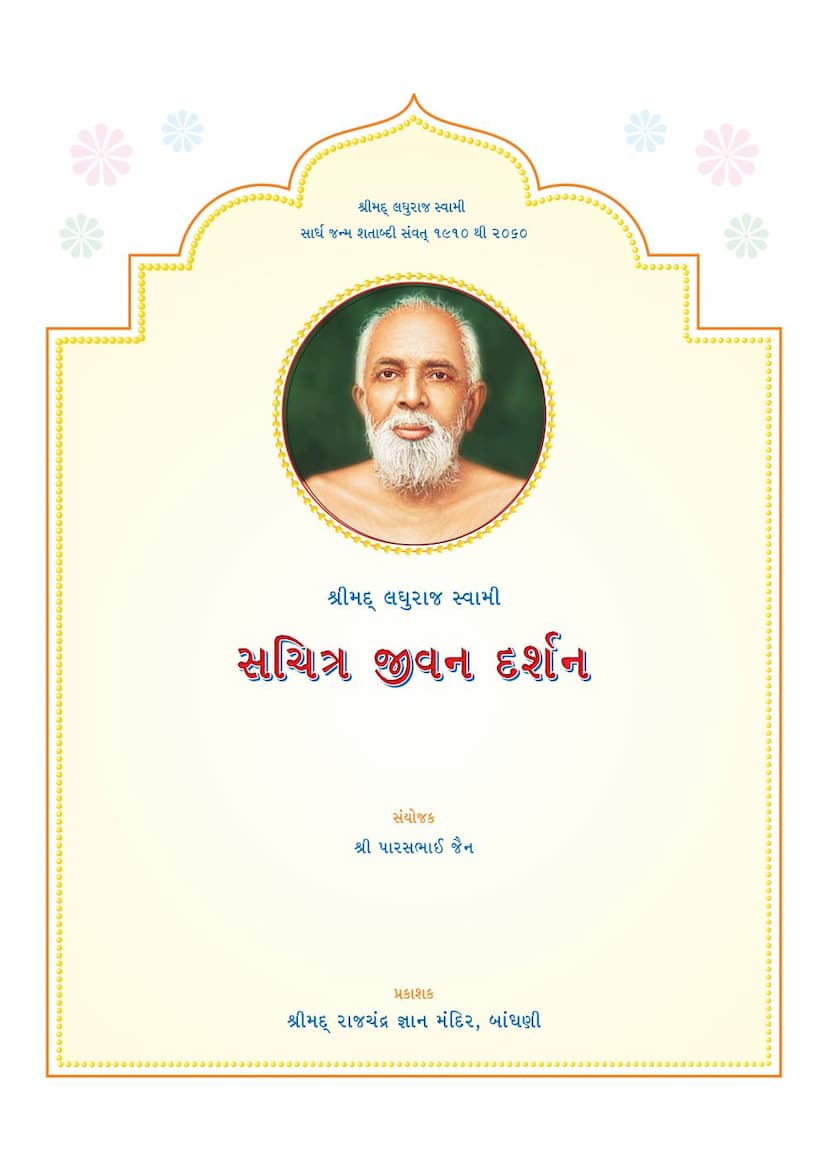Laghuraj Swami Sachitra Jeevan Darshan
Added to library: September 2, 2025

Summary
This document is a comprehensive biographical account of Shri Laghuraj Swami, also known as Prabhu Shriji, a significant figure in the Jain tradition, particularly in the lineage influenced by Shrimad Rajchandra. The book, titled "Laghuraj Swami Sachitra Jeevan Darshan" by Paras Jain and published by Shrimad Rajchandra Gyanmandir Bandhni, aims to present his life and teachings through a collection of his life events and teachings, accompanied by 511 illustrative photographs.
Key Aspects of Laghuraj Swami's Life and Teachings as Detailed in the Text:
- Spiritual Lineage and Influence: Laghuraj Swami was a devout follower of Shrimad Rajchandra, who received spiritual awakening in 1954 in Vasod. Prabhu Shriji played a crucial role in bringing forth the original path of Jainism as taught by Bhagwan Mahavir, as revealed through Shrimad Rajchandra's teachings. His life is seen as an embodiment of these principles.
- Early Life and Renunciation: Born in Vataman village, his birth name was Lallubhai. Despite a prosperous family background and early success in business, he felt a strong calling towards renunciation. A severe illness at the age of twenty-seven, coupled with a profound spiritual inclination, led him to vow to renounce the world if he recovered. This aspiration eventually culminated in his monastic initiation in 1940.
- Monastic Life and Austerities: After his initiation, he diligently followed monastic practices, engaging in rigorous austerities, including fasting and meditation. The text highlights his dedication to spiritual practices like the "Namuthunam" Kaussarg, and his internal struggle with desires, which he discussed with his Guru.
- Encounter with Shrimad Rajchandra: A pivotal moment in his life was his first meeting with Shrimad Rajchandra in 1946. This encounter deeply influenced him, leading him to seek spiritual knowledge and guidance. His requests for "samkit" (right faith) and steadfast celibacy were met with understanding and wisdom by Shrimad Rajchandra.
- Contribution to Jain Principles: The book emphasizes Prabhu Shriji's role in reviving and propagating the core principles of Jainism, including the path of non-violence, detachment, and spiritual self-realization. He is credited with inspiring many through his profound spiritual experiences and unwavering devotion.
- Establishment of Shrimad Rajchandra Ashram: A significant achievement attributed to Prabhu Shriji is the establishment of the Shrimad Rajchandra Ashram at Agas. This ashram became a spiritual sanctuary, a center for Satsang and spiritual practices, attracting thousands of devotees. The ashram's growth and development are detailed, including the construction of a temple, a community hall, and a library.
- Emphasis on Spiritual Practices: The text repeatedly mentions Prabhu Shriji's emphasis on devotion, meditation, and adherence to spiritual practices. He guided his followers on the importance of the "Sahaajatmaswaroop Paramguru" mantra, the "Chha Pad" letter, and the "Aatmasiddhi" scripture.
- Miraculous Events and Devotion: The book narrates several instances that are considered miraculous, highlighting Prabhu Shriji's spiritual powers and the deep devotion he inspired. The text also notes that while external manifestations might attract people, the true essence lies in internal devotion and spiritual realization.
- Interactions with Devotees and Monks: The book is replete with accounts of Prabhu Shriji's interactions with a vast number of disciples, fellow monks, and spiritual seekers from various backgrounds. These anecdotes illustrate his compassionate nature, profound wisdom, and ability to guide souls towards spiritual upliftment.
- Later Life and Legacy: The latter part of the text details his declining health, his continued dedication to spiritual teachings, and his eventual passing. It speaks of his final moments in a state of deep spiritual absorption and his profound impact on the Jain community, leaving behind a rich legacy of spiritual guidance and the established Shrimad Rajchandra Ashram as a testament to his life's work.
- Key Teachings and Principles: The book highlights several core teachings:
- The supremacy of the soul: The emphasis is on recognizing the soul as the true self, distinct from the body and worldly possessions.
- Importance of a true Guru: The necessity of a spiritual guide for achieving self-realization and liberation is repeatedly stressed.
- Detachment and renunciation: The detachment from worldly desires and the practice of renunciation are presented as essential for spiritual progress.
- The power of devotion: Devotion is depicted as a potent force that can lead to spiritual transformation and liberation.
- Following the path of righteousness: Adherence to the teachings of the Tirthankaras and the principles of Jainism is paramount.
- "Maatru-pitru Devo Bhava" and "Atithi Devo Bhava": While emphasizing spiritual pursuits, the text also touches upon the importance of respecting elders and serving guests.
- The significance of vows and austerities: The text illustrates how vows and austerities, when undertaken with sincerity, can lead to spiritual merit.
In essence, "Laghuraj Swami Sachitra Jeevan Darshan" serves as a detailed chronicle of a dedicated Jain spiritual master's life, highlighting his profound spiritual journey, his role in propagating the Jain faith, and his enduring impact on his followers and the broader spiritual landscape.